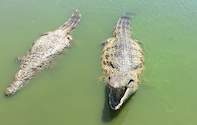
Smell and taste
The olfactory or smelling nerves are all in the nasal area in mammals and birds. The system differs in insects, where the olfactory senses are usually in the antennae. In some reptiles, it may appear that they smell with their tongues but they are in fact picking up particles by flicking their tongues. The tongue (often forked) is then withdrawn and inserted up into the nasal passages where the scent is registered, hence the need to flick the tongues in and out.Scent
Scent, as generally understood, consists of minute, material particles carried in the air. Even the pheromones secreted and released by many insects and other animals consists of molecular particles. These minute particles are carried by the flow of air. It stands to reason that smells are picked up more easily in the direction of the airflow. In the evening, smells are dispersed over the land surface by descending and drifting cool air. In the morning 'smells' will be lifted by ascending air. Winds are strong carriers of scent. For this reason, plants and flowers that rely mainly on scent to attract insect pollinators will be active in the evenings.Others can use their colour during the daylight. Smells can be carried for great distances and even human beings can register them from many kilometres away from the source. As with shapes and colour in vision, there is generally a learning process in understanding the meaning of various smells. In nature, scent is used to detect sources of danger, food, compatibility, territorial marking, water, menstruation and other factors.Generally, the larger the area for olfactory organs, the better that species is able to smell. Animals with long noses have a good sense of smell and animals with short noses have a less developed sense of smell. Thus ungulates and canines have a better sense of smell than cats.There are specialized species such as the aardvark and anteaters that have particularly acute senses. Elephant trunks are not noses as such but elongated nostrils which assist them in picking up scents that are often above the level of other species. In most cases, mammals have well developed olfactory organs while those in birds and reptiles are poorly developed or absent. There are some notable exceptions to this statement.
Extraordinary Smellers
Among birds, the New World vultures generally have olfactory senses, particularly the Turkey and Black vultures, which can pick up rising scent from the forests below.Researchers at Vanderbilt University in the USA have been studying the mysterious star-nosed mole and have found that it can locate and gobble down food in half the time it takes a person to react to a red traffic light. In less than a quarter of a second, in pitch-blackness, the mole's nose can detect an object, decide if it is edible, and guzzle the snack.
The researchers believe that the mole's speed gives the mole a competitive advantage over other burrowing animals, as it allows it to eat much smaller prey. The only way researchers were able to see what the mole's mouth was up to was to use a high-speed video camera. With an average of 230 milliseconds to identify and eat a bit of food, the researchers believe that the mole is moving as fast as its brain and nervous system will allow.Given the speed of its movements, they estimate that it takes eight milliseconds for the mole's brain to decide if what it is touching is edible or not. In order to perform this amazing feat of speed, the mole has what might be the oddest-looking nose in the world of mammals. Twenty-two small fingerlike projections form a star shape around the little animal's nose, and these are in constant motion, tapping their surroundings as the mole burrows.
It was calculated that the star-nose allows it to find 14 times as many small prey animals in a given time than a close cousin, the eastern mole. The mole also has specialized teeth, with much smaller incisors than other moles that are shaped like tweezers to allow it to take advantage of the small delicacies its nose roots out as it burrows. The New Zealand Kiwis have nostrils on the tip of their long bills and can smell prey while probing underground.
Pelagic birds of the open seas, the ones with sheath-bills or tube noses, such as many of the albatrosses, petrels, prions, sheathbill and skuas, have been recorded to follow ocean surface scent, upwind, from many kilometres away. It is not surprising as dogs can easily pick up the scent from bubbles of underwater putrefaction. Crocodiles, fish and other aquatic species are able to pick up minute scent particles underwater.
Among certain insects (notably some beetles and moths) you may have noticed that the females have thin antennae while the males have feathery antennae. The females of these species release pheromones which are carried down wind. The males have been recorded receiving and reacting to these pheromones, which are detected through the feathery antennae, from distances of around 30 kilometres.
By Dave Rushworth

